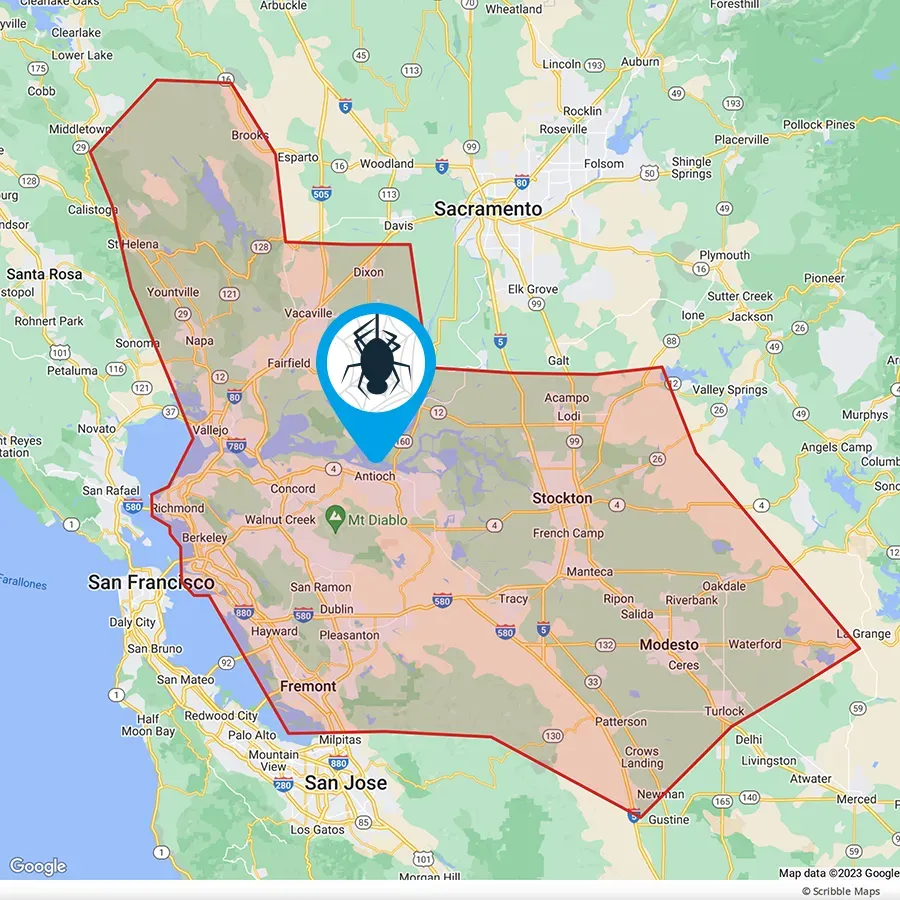Flea Exterminators in Antioch, CA
Fighting a flea infestation isn’t a one-and-done battle. It’s a war that could take an extensive knowledge of their habits and the flea’s life cycle. Luckily you have found the Flea Control Specialists! We have helped families just like yours eliminate these annoying pests from your home.
When you are ready, our Diamond Certified Pest Control Specialists are here to answer your questions and successfully get rid of fleas living in your home.
Top Signs of a Flea Infestation
Have you noticed your pet scratching or licking their skin more than usual? Have you noticed any unusual bites on your skin that are red, swollen and uncomfortable? Identifying a possible flea infestation can often be simple, while eradicating a flea infestation can prove to be a very difficult and extensive process. Here are a few signs that you may have a possible flea infestation.
- One of the clearest signs of a flea infestation is a change of behavior from your pets. This can include, but is not limited to, excessive scratching. If your pet is scratching excessively, you may want to inspect areas such as the hind parts for dogs and the head for cats, since these are typical places for fleas on pets.
- Looking at your pet’s skin and bedding for black droppings. This is ‘flea dirt’ or adult flea feces and looks somewhat like black pepper. A good tip is to use a flea comb and put it in on a white surface to make it easier to see the small black specs.
- The presence of flea bites is also a sign of a flea infestation. If you or your family is experiencing small, itchy bites you have might have a flea infestation.
- It is also important to be aware of flea season. Flea season typically peaks during the hot days of Summer; however these pests can actually be a year-round problem. It is recommended to be aware of fleas, and even take preventive measures to safeguard your pets from them, especially during the spring, before prime-time flea season.
A flea infestation is a complicated and extensive process that requires time and effort to remove. Dealing with an infestation requires treating infected animals, cleaning flea infested areas and taking preventative measures to keep fleas from returning to your home again.
What Fleas Look Like
- Fleas are small, roughly 1mm to 3mm long
- Wingless insects with flattened bodies capable of jumping long distances
- Reddish/Dark brown in color, especially in adult stage
- Seek a host (mammal) for blood in order to survive
Flea life Cycle
Fleas complete a cycle from egg to adult through several larval stages and a pupal stage. Fleas pass through four stages: eggs, larva, pupa, and adult. Cycle length ranges from several weeks to several months and is largely dependent upon environmental conditions.
Fleas lay between four to eight eggs after a meal, with the highest concentrations of laying occurring within the last few days of the female’s life. Flea eggs hatch into larvae within one to 12 days. Flea larvae complete three larval instars and depending on their environment will range in length from about 3 to 5 mm long. They have no eyes or legs, and their body is maggot-like and whitish, but turns progressively darker as the larvae feeds on feces excreted by the adult fleas. Unlike adult fleas, larvae do not take a blood meal directly from a host. The flea’s larval stage is completed within about 4 to 18 days. One of the last activities of flea larvae is to spin a silken cocoon and then enter the pupal stage. The pupal stage may be complete within three days, or it can last as long as one year. Adult fleas begin searching for food when they emerge from the pupal stage. While fleas are noted for their jumping abilities, they will remain stationery when a suitable host is located. Females begin laying eggs within 48 hours of the first feed, thus beginning the life cycle again.
How Fleas Get into Your Home
Fleas are very tiny, but a small amount of them can turn into an infestation that can transfer to all areas of your home. It is important to take initiative to stop a possible infestation of these annoying, and potentially harmful pests.
Fleas, more often than not, come from a pet dog or cat. The pests can attach when the pets spend time outdoors, and then infest the fur, which leads to them being carried inside the home. Being outdoors can lead to exposure to other animals that are not treated and have fleas.
Fleas seek a host for blood in order to survive. On some occasions, fleas may become and inside problem when the host they previously fed on is no longer around, and they would then direct their attention to finding a new host, which could be you or your family, if it has become an indoor flea.
Health Risks from Fleas
Flea bites on humans is a sure sign of a flea infestation, but a majority of the time it’s your beloved pets which first become victim to flea bites.
As with all insect bites, itchiness and swelling will occur around the bitten area, and that’s generally the greatest discomfort from the presence of fleas. However, because fleas are recognized disease and parasite carriers, they can also cause more severe health problem and allergic reactions. it is important to know about the different possible diseases that can be transmitted through fleas.
Fleas may transmit diseases while taking a blood meal from a human or animal host or via contaminated fecal pellets. The number of flea-borne disease cases is relatively minor in the U.S. but with the increase of people traveling internationally, potential spread of diseases by flea species is now a potential issue and can affect more people than ever before.
Fleas are known to transmit parasites, such as tapeworms, which primarily affect pets. Adult fleas infected with tapeworm may be accidentally ingested by cats or dogs, and they can run health risks. They can also cause anemia and iron deficiencies resulting from a large population of blood-feeding fleas.
Some of the known diseases fleas are known to carry and spread include:
The Bubonic Plague
- The most well-known flea transmitted disease is the bubonic plague. It became an epidemic in the 14th century, killing 25 million people, which at the time was around 50% of the European population.
- Today, the plague still occurs worldwide but there have only been a handful of cases each year reported in the U.S. The plague is carried by rodents and transmitted to fleas that bite them, which is how it is transferred to human and pets.
Murine Typhus also known as Flea-Borne Typhus
- This is a rare disease in North America but there have been a few cases reported each year, including recently with some cases reported in the Los Angeles area. This disease typically occurs in rat-infested areas, where fleas become infected by rats and then pets bring infected fleas into the home.
Tungiansis
- This disease is rarely diagnosed in North America but due to people continuously traveling internationally, there is potential for the spread of this disease. It is typically transmitted by the burrowing flea (which is also known as the sand flea), where the flea anchors itself onto the skin and burrows into the epidermis.
Tularemia
- Occurs in areas in North America and has the potential to be a serious illness. It is caused by bacteria and is often found in animals, such as rodents. It can then be transferred to humans by an infected flea or tick bite.
Bartonellosis also known as Cat Scratch Disease
- Transmitted to humans from the bites of the oriental rat flea and cat flea but can also be transmitted by contaminated bites of animal, scratch, and ingestion.
Vector-Borne Disease
- Vector-borne diseases are those transmitted by fleas or ticks, as well as other parasites, that infest dogs and cats which can then go on to affect people.
Types of Fleas We Eliminate
There are various types of fleas that thrive across the U.S.
- Cat Fleas – This is the most common flea that infests cats, dogs, humans, and wild animals.
- Dog Fleas – Preying on similar hosts just like the cat flea, this specific type isn’t as widespread.
- Human Fleas – These fleas enjoy taking blood meals from humans and pigs.
- Chigoe Fleas – Known as sand fleas, these feed on people near tropical beaches.
- Sticktight Fleas – These pests harm those in contact with squirrels, poultry, and other birds.
- Rat Fleas – Both the oriental and northern species feed on Norway and roof rats and spread various diseases.
- Bird Fleas – Can multiply enormously in hen houses, breeders, and other similar environments.
Of all these different types of fleas, cat fleas are the most common issue in California. This specific type has one of the broadest host ranges of any type of flea. Unlike other species, cat fleas stay on their hosts after feeding, mating, and depositing flea eggs. The egg larva falls off pets, and spreads to other areas around the home.
Our Flea control process
When you are experiencing a flea infestation in your home, your treatment plan will require you to take two stages of action. The first stage is an exclusion treatment for your home to prevent fleas from gaining access, as well as to protect your beloved pets as well. The second stage involves regular maintenance visits to ensure that the fleas don’t return as they are able to easily transmit to your pets in various locations.
Flea Inspection and Estimate
When you have a Flea Problem, you want to get rid of it immediately. You can count on All N One Pest Eliminators to be at your home within 24 hours of your first call. Our Pest Control Specialist will speak with you to understand the current issue and major points of concern. They will then inspect your home for potential causes for the current issue and additional pest and rodent related areas of concern that may appear. Once your tech has completed the inspection, they will discuss their recommended treatment options with you and provide an affordable pest control estimate for you to review.
Exterior Flea Treatment
With our Pest Control Strategy in place our technicians will jump into action. The first step in our process is to identify any potential host for the fleas, this may include your pets, or any outdoor space. Your pest specialist will monitor all possible locations the fleas could have had access to as well as if the fleas were located on your property or just exposed and brought into your home from an outside source.
Flea Removal
Once the exterior of your home is secure, the next step is to do an interior flea removal, if needed. (This will be determined in the initial inspection.) We take great care to use the most environmentally friendly, humane, and safe trapping practices available to protect your family and pets.
Follow Up/Successful Completion of Exclusion and Removal Treatment
Your initial pest control exclusion and removal treatment will conclude when we have two consecutive weeks of inspection with no signs of flea activity. This includes no additional indicators of flea activity such as flea feces, flea eggs, or fleas at all.
Continued Pest Control Maintenance
It has been said that, “The only real defense is an active defense.” A successful Residential Rodent and Pest Control Strategy includes proper maintenance and prevention. With the All N One Rodent Control & Maintenance Package, you can rest assured that your family and home are protected year-round from all types of pests, especially those annoying fleas. Our Pest Control Specialists will make regular visits to your home to re-treat your home and identify any potential pest threats.
Treatment Types
Qualified technicians understand all the problems when it comes to dealing with different types of fleas. Through the use of experts, discrete, tailored solutions and advice will be provided to you, so your flea problem is sorted without disrupting your daily life.
- Highly effective sprays or chemical-free heat treatments to target your particular situation.
- Using insect growth regulators that interfere with the normal development of fleas from egg to adult stage.
- Conducting a thorough inspection to locate and identify flea sources both inside and outside the home.
- Using vacuums to physically remove all flea stages from carpets, furniture and in pet bedding areas.
- Using carpet cleaning equipment and frequently washing and drying pet bedding to kill fleas.
- Educating the property owner about flea habits, behavior and habitats.
- Recommending that property owners consult with their pet’s veterinarian for advice regarding pet-related products and how to properly bathe and groom pets.
Tips for Preventing Future Flea Problems
Upon identifying an infestation, clean your home thoroughly and treat your pet with veterinarian-recommended flea remedies. Linens and pet beds should be washed or possibly even discarded. For mild or light infestations, it is recommended to wash any bedding thoroughly in hot, soapy water, necessary for killing fleas and destroying the eggs and larvae. For heavy infestations it is best to destroy and discard all pet bedding.
There is plenty of wildlife that also carry fleas, such as rats and mice, so it is important to check your pets regularly using flea combs.
Even if your pets don’t have fleas, it’s important to keep them on flea control and prevention. There are many different types of treatments for dogs and cats available, from spot treatments such as Frontline, flea shampoos, flea collars, or oral medication that you can get from your vet.
When moving into a new home, spend some time inspecting carpets and flooring carefully for signs of eggs or ‘flea dirt’. If the previous occupant was a pet owner, there might be a possibility for some flea larva and pupa waiting around.
Because fleas are such a persistent and complex issue to handle, it’s a good idea to call in the pros. For the safety and comfort of your pets and everyone else in your house, flea prevention is key. It’s a good idea to bring in an expert to examine your home and give you some specific changes you can make to keep fleas out or get rid of any that are already there.
Over the Counter Flea Control Solutions & Limitations
Flea Bombs
- Flea bombs treat indoor flea infestations through direct application of chemicals. They are designed to be left alone to release pesticides into the room and kill fleas.
- While flea bombs sound like an effective solution for indoor flea infestations, their chemicals often do not reach hidden or sheltered areas. Fleas take shelter in these areas and they will be unaffected by the flea bomb and therefore not controlled. Flea bombs also do not address outdoor infestation or animal infestation. Also keep in mind that only certain stages of the flea’s life cycle will be affected.
- Flea bombs also leave behind a residue on surfaces and can contaminated food and surfaces.
Flea Traps
- Flea traps capture some fleas, but the greatest value in a flea trap is as a monitoring tool not a control tool. They can serve as a warning device to let the owner know that there might be a possibility of a flea problem. Traps only catch adult fleas and have very little impact on eggs, larval, and pupal flea stages.
Consumer Spray Products
- While a consumer spray product will kill fleas, one shouldn’t just solely rely on sprays. Consumer spray products are usually not as long lasting as those products used by pest management professionals.
Diatomaceous Earth
- Diatomaceous Earth is the microscopic remains of fossilized algae, diatoms. It’s a very fine powder, which is non-toxic to humans and it is a great natural remedy to get rid of fleas as it causes dehydration.
- Be aware that although diatomaceous earth is non-toxic, the nature of the powder can get messy and irritate your eyes and throat.
For some serious infestations, steam cleaning before vacuuming is necessary. The heat can kill almost all the adult fleas but may not kill all the eggs. Continue to vacuum every other day after the steam cleaning to make sure you are killing fleas as they hatch. Some might still make it to the adult stage. Insecticides are almost always a necessary third step in moderate to severe flea infestations, even after steam cleaning and vacuuming.
Yet even then, most common flea control sprays fail to kill the pupae, which means you will likely see a few fleas over the next two weeks. Keep vacuuming, as it stimulates the fleas to hatch prematurely, thus exposing their bodies to the residual pesticides. Vacuuming should be enough to control the lingering population if you’ve treated your pets. This is a lot of work, and not as easy or effective as calling a pest management professional.

Flea Control Service Area
All N One Pest Eliminators proudly serves customers in Northern California. Our experienced exterminators are capable of providing safe and effective pest control services to any location in our service area. Our service area includes the following:





